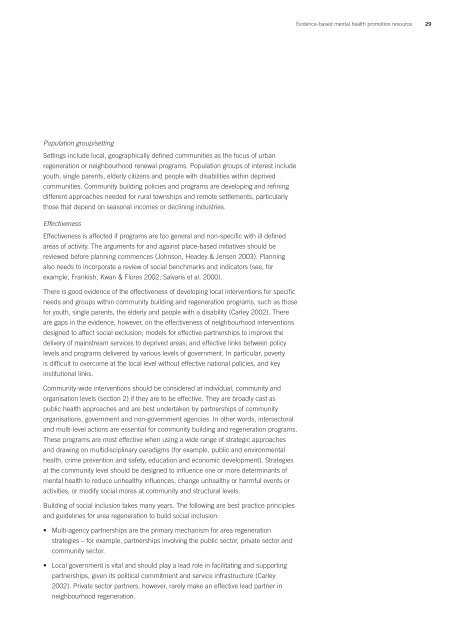Evidence-based mental health promotion resource - health.vic.gov.au
Evidence-based mental health promotion resource - health.vic.gov.au
Evidence-based mental health promotion resource - health.vic.gov.au
You also want an ePaper? Increase the reach of your titles
YUMPU automatically turns print PDFs into web optimized ePapers that Google loves.
<strong>Evidence</strong>-<strong>based</strong> <strong>mental</strong> <strong>health</strong> <strong>promotion</strong> <strong>resource</strong>29Population group/settingSettings include local, geographically defined communities as the focus of urbanregeneration or neighbourhood renewal programs. Population groups of interest includeyouth, single parents, elderly citizens and people with disabilities within deprivedcommunities. Community building policies and programs are developing and refiningdifferent approaches needed for rural townships and remote settlements, particularlythose that depend on seasonal incomes or declining industries.EffectivenessEffectiveness is affected if programs are too general and non-specific with ill definedareas of activity. The arguments for and against place-<strong>based</strong> initiatives should bereviewed before planning commences (Johnson, Headey & Jensen 2003). Planningalso needs to incorporate a review of social benchmarks and indicators (see, forexample, Frankish, Kwan & Flores 2002; Salvaris et al. 2000).There is good evidence of the effectiveness of developing local interventions for specificneeds and groups within community building and regeneration programs, such as thosefor youth, single parents, the elderly and people with a disability (Carley 2002). Thereare gaps in the evidence, however, on the effectiveness of neighbourhood interventionsdesigned to affect social exclusion; models for effective partnerships to improve thedelivery of mainstream ser<strong>vic</strong>es to deprived areas; and effective links between policylevels and programs delivered by various levels of <strong>gov</strong>ernment. In particular, povertyis difficult to overcome at the local level without effective national policies, and keyinstitutional links.Community-wide interventions should be considered at individual, community andorganisation levels (section 2) if they are to be effective. They are broadly cast aspublic <strong>health</strong> approaches and are best undertaken by partnerships of communityorganisations, <strong>gov</strong>ernment and non-<strong>gov</strong>ernment agencies. In other words, intersectoraland multi-level actions are essential for community building and regeneration programs.These programs are most effective when using a wide range of strategic approachesand drawing on multidisciplinary paradigms (for example, public and environ<strong>mental</strong><strong>health</strong>, crime prevention and safety, education and economic development). Strategiesat the community level should be designed to influence one or more determinants of<strong>mental</strong> <strong>health</strong> to reduce un<strong>health</strong>y influences, change un<strong>health</strong>y or harmful events oractivities, or modify social mores at community and structural levels.Building of social inclusion takes many years. The following are best practice principlesand guidelines for area regeneration to build social inclusion:• Multi-agency partnerships are the primary mechanism for area regenerationstrategies – for example, partnerships involving the public sector, private sector andcommunity sector.• Local <strong>gov</strong>ernment is vital and should play a lead role in facilitating and supportingpartnerships, given its political commitment and ser<strong>vic</strong>e infrastructure (Carley2002). Private sector partners, however, rarely make an effective lead partner inneighbourhood regeneration.



